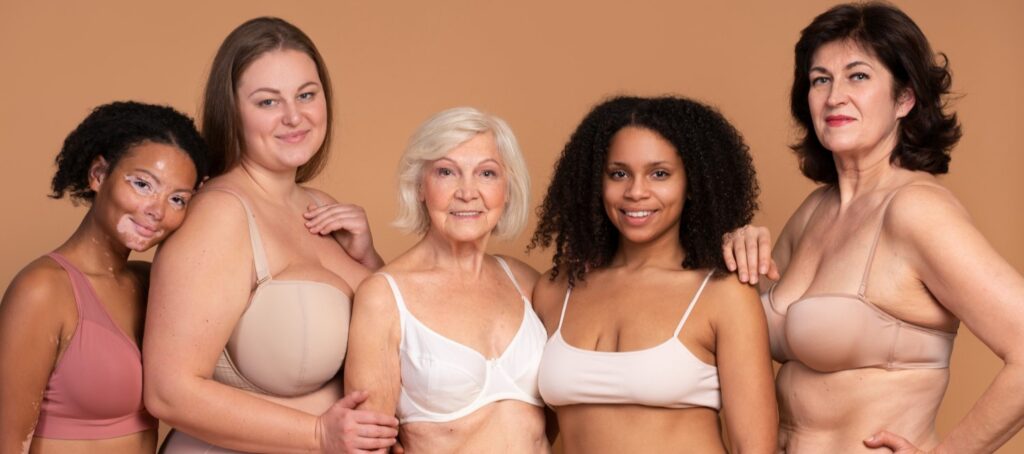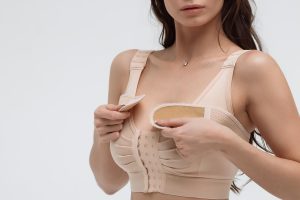Have you ever wondered what the average bra size is for your age? This is a question many women ask, and the answer can be more complex than it seems.
Bra size isn’t just a number, it reflects changes in the body throughout different life stages. With so many variables at play, understanding how and why these sizes change can be a fascinating journey.
Whether you’re in your teenage years, adulthood, or beyond 40, know that transformations in your body directly impact the size of the bra you wear. We’ll explore the factors that influence these changes and how you can determine the ideal size for yourself.
Additionally, we’ll discuss how to measure your size correctly, ensuring you always find the perfect fit. Ready to discover all this and more? Then keep reading!
What is bra size?
Bra size is composed of two main measurements: the band size (number) and the cup size (letter).
This combination is essential to ensure that the bra fits correctly and provides the necessary support.
Band size
The band size is the number you see in a bra size, such as the “36” in 36C. This measurement is taken around the ribcage, just under the breasts, and indicates the circumference of your body.
It’s crucial that this measurement is accurate, as a band that is too tight can cause discomfort, while a band that is too loose may not provide adequate support. For most women, this measurement varies throughout life, reflecting natural changes in the body.
Cup size
The cup size, represented by the letter, indicates the volume of the breast. For example, in 36C, the letter “C” refers to a specific cup size. To determine the cup size, you measure around the fullest part of the breast and find the difference between this measurement and the band size.
This difference is key, as it determines comfort and how well the bra fits the body. An ill-fitting cup can result in breasts being either too tight or poorly supported.
Read more: Breast Asymmetry: Causes, types and treatment
The average bra size at different ages
Let’s explore how the average bra size varies across different life stages, from adolescence to advanced age, and what factors influence these changes.
Adolescence and early adulthood (12-25 years)
During adolescence, bodily changes can be quite dramatic. Many girls start wearing bras around the age of 12, and this transition is unique for each individual.
According to research, the average bra size in this age group generally ranges from 32B to 34B. As young women enter adulthood, the size may increase to 34C or even 36C, reflecting the natural development of the body.
- Genetics: Family traits play a significant role in breast size. If the mother or sisters have a certain size, it’s likely to influence the daughter.
- Hormonal changes: The menstrual cycle and other hormonal factors can temporarily affect breast size. For example, many women notice an increase in breast size during ovulation or before their period.
- Weight: Weight gain or loss can impact breast size and, consequently, bra size. During adolescence, it is common to experience weight fluctuations, which can lead to changes in bra size.
Adulthood (26-40 years)
In adulthood, bra size tends to stabilize, but it can still vary. The average size for women in this age group is usually around 36C to 38C. During this phase, many women also experience changes due to pregnancy and breastfeeding, which can permanently affect breast size.
Pregnancy and breastfeeding
Pregnancy is a period of transformation not just for life but also for the body. During gestation, breasts may enlarge in preparation for breastfeeding. Some women may experience a significant increase, while others may notice more subtle changes.
After breastfeeding, some women see a decrease in size, while others may experience a permanent change, making them more aware of the importance of a proper bra fit.
Older age (41 years and up)
As the years go by, many women notice changes in their bodies. The average bra size for women in this age group can vary between 36D and 38D. This change is often attributed to skin sagging and hormonal changes that accompany menopause. These changes can affect not only size but also the shape of the breasts, making it even more crucial to find a bra that offers the right support.
| Age Range | Average Bra Size |
| Adolescence (12-25 years) | 32B – 36C |
| Adulthood (26-40 years) | 36C – 38C |
| Older Age (41 years and up) | 36D – 38D |
The importance of a good fit
Regardless of age, it’s essential for women to wear bras that fit properly. A well-fitting bra not only provides comfort but can also improve posture and overall back health. A poorly fitting bra can lead to discomfort, back pain, and even postural issues.
Considering a professional fitting can be an excellent option, especially as the years go by, ensuring that you always have the support you need, no matter the changes your body may undergo.
Read more: How to choose the best cosmetic procedure for your body?
Tips for finding the right size
Finding the right bra size may seem challenging, but with a few simple tips, you can ensure that you are wearing a bra that not only fits well but also provides comfort and adequate support. Here are some guidelines to help you in this process.
1. Measure regularly
One of the best practices for finding the right bra size is to take body measurements at least once a year. As your body changes due to factors like aging, weight fluctuations, or even hormonal changes, your bra size may vary.
- How to measure: Use a measuring tape and follow the steps mentioned earlier to measure the band and cup size. Remember, it’s important to take these measurements with your body relaxed and in a well-lit environment to ensure accurate results.
2. Try different styles
There isn’t a single bra style that works for all women. Different brands can have varying cuts and styles, which can affect how the bra fits your body. Therefore, it’s essential to try out several options.
- Varied styles: From padded bras and sports bras to seamless options, there is a wide variety available. Experiment with different styles to see which one fits your body and meets your needs best. What works well for one person may not be the best choice for another.
- Visit physical stores: If possible, go to a lingerie store and ask for assistance from a salesperson. They often have experience in finding the right fit and can offer personalized suggestions.
3. Consider comfort
Size may vary, but comfort should always be a priority. If the bra isn’t comfortable, it doesn’t matter what size it is; you probably won’t want to wear it.
- Move around: When trying on a bra, move around. Raise your arms, bend over, and make some movements to see how it behaves. A comfortable bra should stay in place and not cause discomfort in any position.
- Pay attention to seams and straps: Check if the seams and straps of the bra are not too tight or irritating your skin. A good bra should have a firm yet comfortable fit without leaving marks on the skin.
Finding the right bra size is essential for ensuring comfort and support throughout the day. By measuring regularly, trying different styles, and prioritizing comfort, you can be confident that you are making the right choice.
Remember, a well-fitted bra not only improves your appearance but also boosts your confidence and overall well-being.



